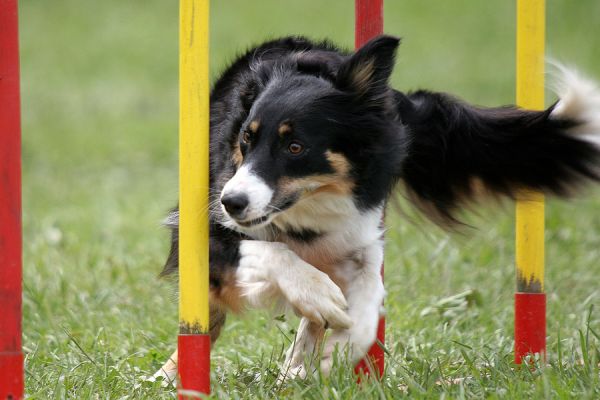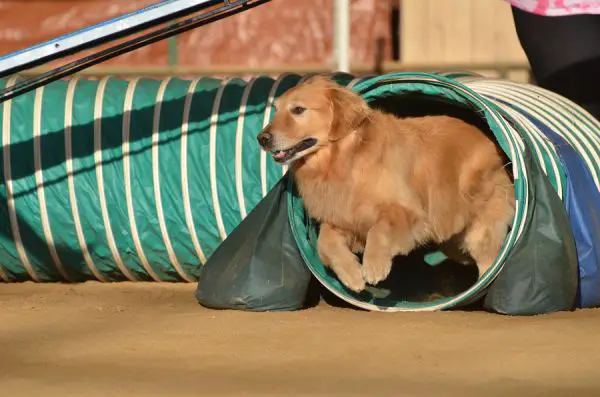
This is a placeholder text
Group text
An Introduction to Agility
Agility is one of the fastest growing sports with dogs of all breeds and styles taking part. It is a challenging, fast paced, and exciting training experience for both dog and handler.
The Beginning of Agility
 Agility is a relatively young sport having only developed a few decades ago in England. In the late 1970s, an agility-like demonstration was put on as entertainment between events at a Crufts dog show. What amazed people was the skill and agility the dogs demonstrated. While we would recognize many of these early obstacles used, there were differences such as a higher jumping height, but items such as early weave poles, A-frame, and dog walk were part of the display.
Agility is a relatively young sport having only developed a few decades ago in England. In the late 1970s, an agility-like demonstration was put on as entertainment between events at a Crufts dog show. What amazed people was the skill and agility the dogs demonstrated. While we would recognize many of these early obstacles used, there were differences such as a higher jumping height, but items such as early weave poles, A-frame, and dog walk were part of the display.People were fascinated by the display which encouraged a massive growth and development in the actual agility sport. The start of the 1980s saw the British Kennel Club become the first organization to create agility rules and agility tests. It wasn’t until a couple decades later that other English organizations began offering agility trials and the Kennel Club wasn’t as dominate a force.
Agility has spread into other countries in the world at a slightly slower pace to start with. The sport was introduced in Canada and the United States in the 1980s, and between the mid and late 1980s, the sport respectively got its real start in both countries. USDAA (United States Dog Agility Association) formed in the mid 1980s, and the AKC (American Kennel Club) didn’t begin offering their version of agility until the early 1990s. The FCI governs much of the international part of the sport with an international championship, and the USDAA has also reached beyond North America for its Grand Prix of Dog Agility events.
How Does Agility Work
Agility requires very good communication between dog and handler. The dog will use both verbal and body cues (such as lowered/turned shoulder, change of handler’s eyesight direction, or hand signals) to navigate through a course of pre-determined obstacles. A handler will never know what a course will actually look like prior to the day of the show.At a trial, a handler is allowed the opportunity to do a ‘walk-through’ of the course without the dog. This 15 minutes allows all the handlers to move through the course, memorize the pattern of it (although obstacles are numbered, it is too hard to try and read the numbers while running), and determine the best way to move your dog through it. A fast dog won’t be handled the same way a slower one will be. Each handler must take into account his dog’s running style and handle the course the best way for that dog. It is not unusual to see handlers squatting or kneeling during the walk-through as they attempt to see what the dog will see on the course.
Courses are determined by the judge of that trial, and the complexity and length are determined by the level the dog is in. The goal is to run the course as quickly and safely as you can with as few faults as possible.
Each organization varies slightly in rules and obstacles, so it is important to inform yourself on the basic organizations near you and what their rules are. The best way to get a feel for the sport is to then go watch a few shows and see how the dogs and handlers move.
The Obstacles 
As noted, each organization varies a bit in what a handler and dog will encounter in terms of obstacles and jumps, but as a general rule, these are the most common items:
- A-Frame: This is a two sided wooden obstacle that resembles an A. A dog should climb and go up and over on command. This is also similar to an obstacle used in Schutzhund.
- Dog Walk: This is a three level obstacle that includes a 10-12 foot long up ramp, a flat/level bridge, and a 10-12 foot long down ramp. The challenge for most beginner dogs, especially large ones, is the narrowness of the boards.
- See Saw: This is really like the children’s playground see saw. A dog is required to mount the board in its downward position and climb toward the upraised end, thereby gradually lowering it with his body.
- Pause Table: This is a low table the dog must jump onto and wait on for a period of about 5 seconds before moving to the next obstacle.
- Weave Poles: This is a series of poles in a line (10-12) that the dog must bend his way through. He should always enter on the left of the first pole (regardless of where the handler is positioned) and weave his body in and out of each pole until the end.
- Tunnel: This is a fully open tunnel, but it can be shaped into a straight line or folded into more of a U shape. Sometimes the dog can see the opening at the end, and sometimes his journey will be dark.
- Closed Tunnel or Chute: This obstacle has an opening at the beginning, but the tunnel or chute quickly flattens. The dog cannot see out the end, and he must open up the fabric as he runs through it.
- Tire Jump: This is a jump utilizing a tire-like shaped ring that is suspended above the ground. The dog must jump through the circle and no where else.
- Jumps: There are a variety of jumps to include single jumps, double and triple jumps, broad jumps, panel jumps, winged jumps, etc. The main goal with all is to have the dog jump over them.
Training for Agility
If you’ve not competed or trained in agility before, it is best to begin in a class with your prospective dog. Classes are as much about teaching the dogs the obstacles as they are about teaching the person how to handle.Many trainers like to begin their dogs training for agility by getting the dog comfortable on items like a wobble board or moving over items like a ladder. Encourage your dog to learn to climb. The more comfortable the dog is with moving over items he sees, the better you’ll be.
Additionally, at the foundation of agility training should be basic obedience. While your dog doesn’t need to know how to heel, he should reliably understand sit, down, come, and stay, but there will be additional commands that will come into play with agility along the way. If working with a puppy, make sure you get the puppy accustomed to new places, new footing, and lots of sound and commotion. This prepares him not only for training but also for shows.
Start your search for a training class with an internet search and asking local kennel club members. There are agility clubs and training facilities all over the place. Some are more competition focused; whereas, others are more focused on just fun. Consider acquiring some equipment for your yard, if this is a possibility, as it will really help your training. Many items can be inexpensively purchased or can be easily made in a weekend.
Contact information Disclaimer Privacy Statement Copyright Information Terms of Service Cookie policy ↑ Back to top




